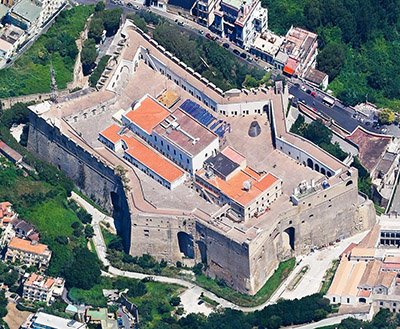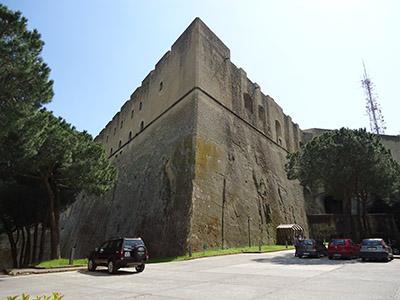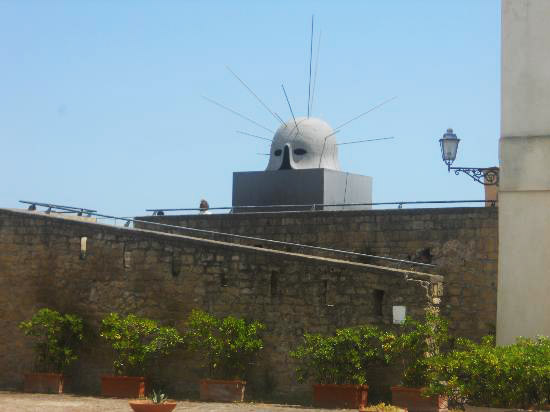 |
Castel Sant'Elmo
Naples, Italy
|
|
 |
Constructed: 1537 - 1547
Used by: Spain, Austria,
Parthenopaean Republic, France, Italy
Conflicts in which it participated:
Several
|
The ancient city of Naples has a long, storied history that reaches back thousands of years, but its starfort history starts at the beginning of the 16th century. The Spanish defeated the French in the Battle of Garigliano on December 9, 1503, in one of the decisive events of the Second Italian War (1499-1504), which was essentially fought over the control of Naples.
Structures had existed on the hill of St. Erasmus since the Normans built Belforte there in 1275, as the hill afforded a commanding view of the surrounding city and all of its approaches, sea and land.
|
 |
|
|
The fortification that stood on St. Erasmus at the time of the Second Italian War had been built during the reign of Charles of Anjou (1226-1285), and had been severely damaged in an earthquake in 1456. Once the Spanish gained control of Naples in 1503, a plan to fortify the city with four separate strongholds began to take shape. Construction of Castel Sant'Elmo (possibly given its name by a centuries-long strangulation of the name St. Erasmus that doesn't seem all that likely, but is the only explanation I can find after endless years of tireless research) began in 1537, based on the design of military architect Pedro Luis Escrivà (b. 1490).
Escrivà, who worked for Holy Roman Emperor Charles V (1500-1558), was one of the earliest designers of starforts: As such he spent a great deal of time defending his revolutionary fortification ideas from the criticisms of traditional military engineers, who still thought the castle concept could not be improved upon, despite radical advances in artillery. Thank you for your meritorious service in the name of the starfort, Pedro Luis Escrivà.
|

Mount Vesuvius last erupted from March 18 to 23, 1944. This was during the Second World War, and USAAF B-25 bombers were conveniently stationed nearby: Photo op! |
 |
About five miles east of Naples is Mount Vesuvius, a volcano whose famous eruption in 79AD destroyed the nearby towns of Pompeii and Herculaneum, killing some 16,000 people. Vesuvius erupted on a semi-regular basis until the end of the 13th century, which was possibly why Charles V felt comfortable with throwing lots of money into Naples' fortification. Castel Sant'Elmo was built out of tuff, a rock formed from a volcano's magma.
By the time Mount Vesuvius resumed its eruption schedule in December of 1631, Naples was one of Europe's most populous cities, second only to Paris.
|
|
|
Naples somehow managed to escape the fate of obliteration by volcano that seemed inevitable. Nature was determined to get the Castel one way or another, however, and thus lightning struck the fort's munitions depot in 1587, setting off a massive explosion that destroyed the church, chaplain's house and officers' quarters residing therein. 150 were killed in the blast, which also damaged part of the city. The Castel was repaired from 1599 to 1601, thereafter being utilized as a prison in addition to its defensive role.
|
Spain lost possession of Naples with the conclusion of the War of the Spanish Succession (1701-1714), and for a brief period the Austrian flag flew o'er the Castel Sant'Elmo. The War of Polish Succession (1733-1738) returned Naples to the loving bosom of the Spanish once again.
As was the case with just about every place in Europe at the end of the 18th century, the French Revolution screwed up everything for everybody. Thinking that Republicanism sounded swell, Neapolitans started rubbing their hands together and making dastardly plans to overthrow the King of Naples, Ferdinand I (1751-1825). No less personage than Vice-Admiral The Right Honourable The Lord Nelson (also known as Horatio Nelson (1758-1805), British naval hero of the Battle of Trafalgar (1805), of whom the British people are particularly admiring) showed up in Naples in 1798, warning anyone who would listen about the wicked perils of Republicanism.
|
 |

Castel Sant'Elmo towers over, hulks above, absolutely menaces its surroundings, although Napolians seem to feel relatively unthreatened by it in this day and age. |
|
The Neapolitans' reaction to this was, "Horatio whom?" and though not everyone in the city was down with this Republican business, King Ferdinand was chased off and the Republicans captured the starfort of our current interest at the beginning of 1799...which of course went a long way towards controlling all of Naples. On January 21, 1799, the flag of the Republic of Naples was raised o'er Castel Sant'Elmo.
|
 Castel Sant'Elmo's northernmost bastion. Pointy, pointy. Castel Sant'Elmo's northernmost bastion. Pointy, pointy. |
 |
This also initiated the French-backed, yet difficult to pronounce, Parthenopean Republic. This grand Republic lasted just shy of five months, before an anti-revolutionary army was raised, and the French and their Neapolitan lackeys were sent on their way, bleeding from their hindquarters.
After this mess was resolved and Ferdinand restored, many many folks who had said nice things about the Republic were incarcerated at Castel Sant'Elmo. The Castel remained a military prison until the 1970's. Much work was undertaken to scrub the blood off its interior walls, and in 1988 the Castel was finally opened to the public as a museum.
|
|
|
 A weird spiky helmet-thing that graces the Castel's western bastion. Italians. A weird spiky helmet-thing that graces the Castel's western bastion. Italians. |
|
|
|
|
|
 |




